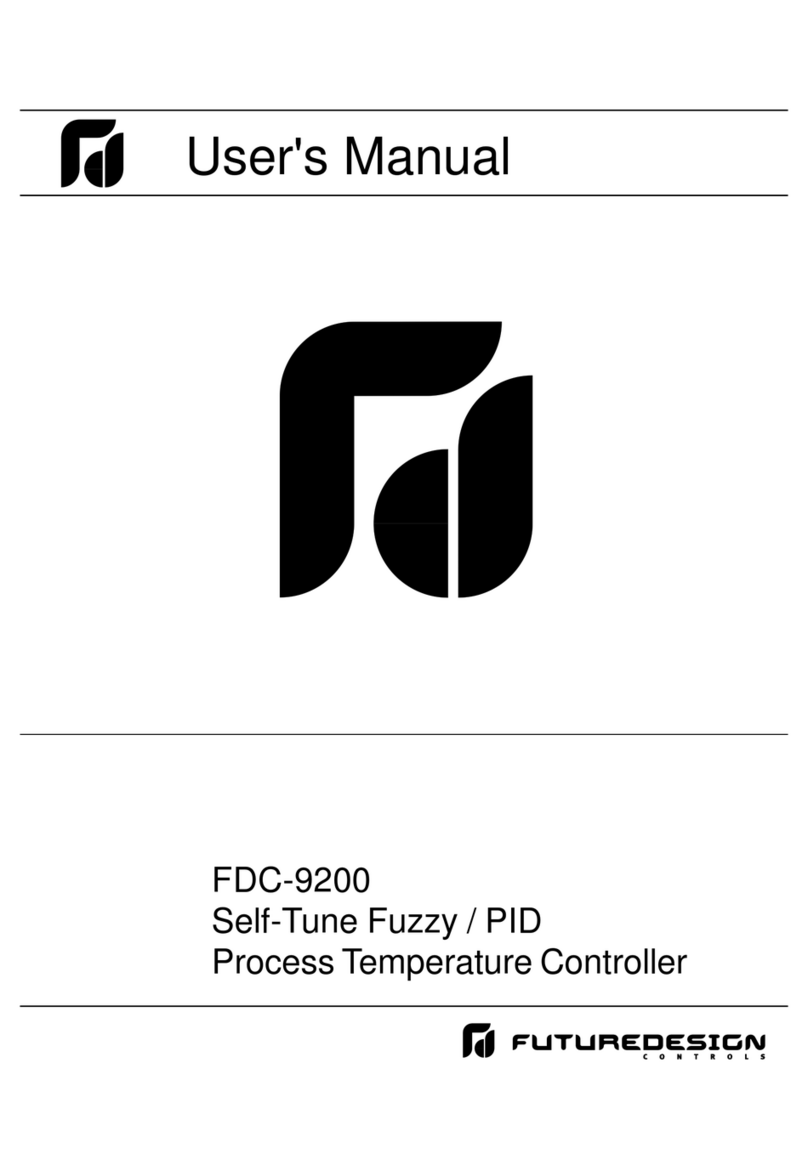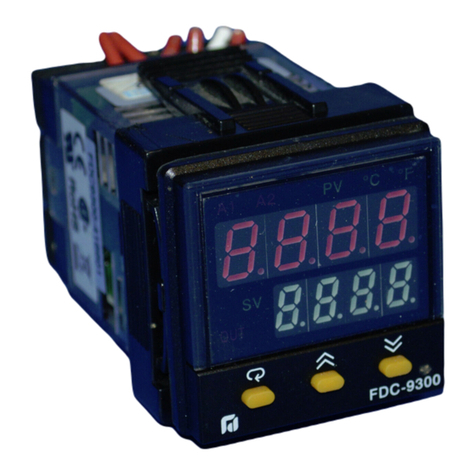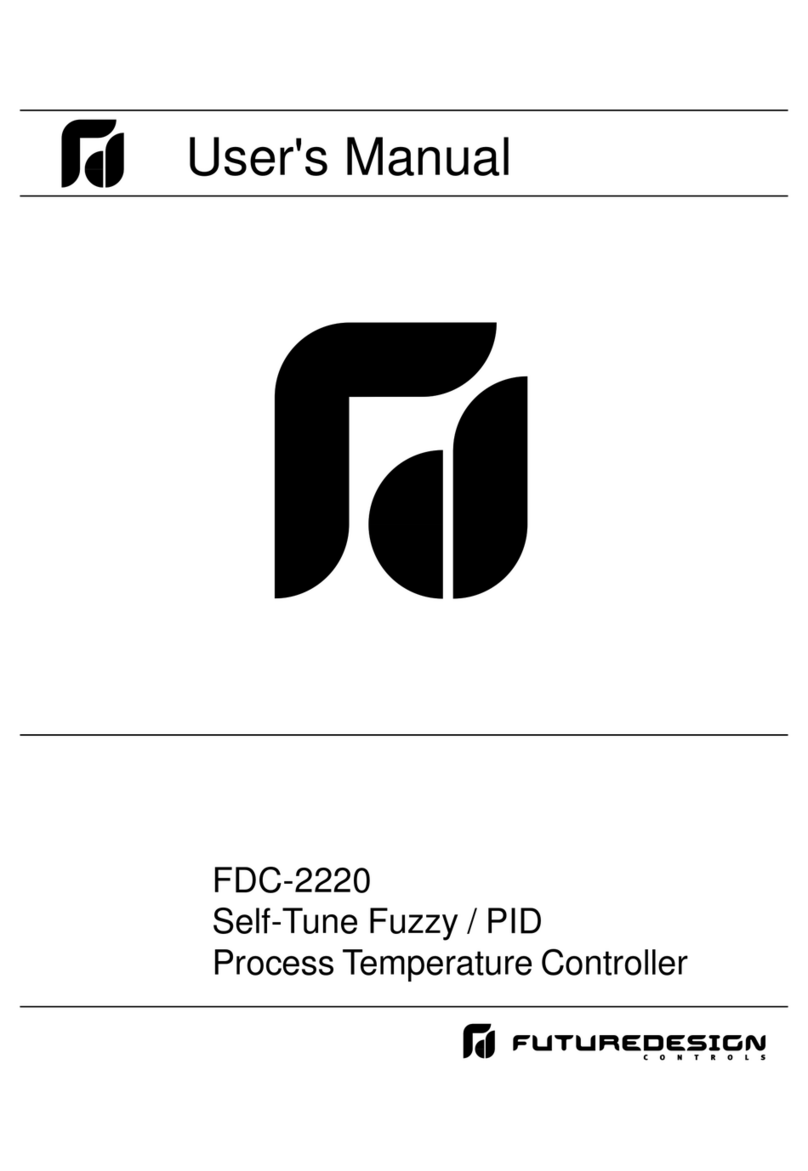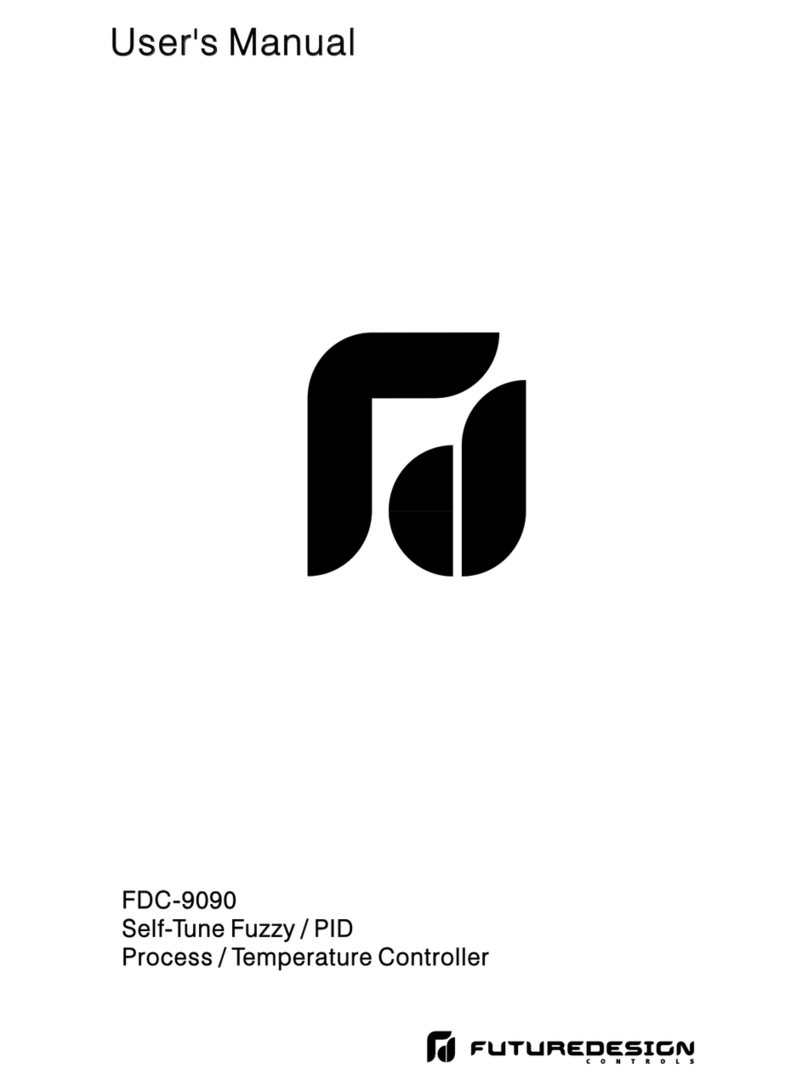
J, K, T, E, B, R, S, N.
PT100 ohm RTD (PTDN or JIS)
-10 to 60 mV, configurable input attenuation
User configurable, refer to Table above
Refer to Table above
0.1 C/ C ambient typical
Protection mode configurable
100 ohms max.
60 dB
120dB
3 times / second
The Fuzzy Logic is an essential feature of this versatile
controller. Although PID control has been widely accepted by
industries, it is difficult for PID control to work with some sophistic
systems efficiently, for example, systems of second order, long
time-lag, various set points, various loads, etc. Because of
disadvantage of controlling principles and fixed values of PID
control, it is inefficient to control the systems with many
variables and the result is unacceptable control for some
systems. The Fuzzy Logic control can overcome the
disadvantage of PID control only. It controls the system in a
efficient way by experiences it had before. The function of Fuzzy
Logic is to adjust the PID values indirectly in order to making the
manipulation output value MV adjusts automatically and quickly
to adapt to various processes. It enables a process to reach its
set point in the shortest time with minimum overshooting during
tuning or external disturbance.
SYSTEM
PID
FUZZY
MV PV
_
+
SV
+
+
PID+FUZZY CONTROL
PID control with properly tuned
PID + Fuzzy control
Warm Up Load Disturbance
Set point
Temperature
Time
2. Model Order Matrix2. Model Order Matrix
FDC
(1) (2) (3) (4) (5) (6) (7) (8)
(1) Power Input
4 90-264VAC
5 20-32VAC/VDC
9 Other
(2) Signal Input
5 Configurable (Universal)
9 Other
(3) Range Code
1 Configurable
9 Other
(4) Control Mode
3 PID / ON-OFF Control
(5) Output 1 Option
0 None
1 Relay rated 3A/240VAC resistive
2 SSR Drive rated 20mA/24V
3 4-20mA linear, max. load 500 ohms (Module OM93-1)
4 0-20mA linear, max. load 500 ohms (Module OM93-2)
5 0-10V linear, min. impedance 500K ohms (Module OM93-3)
9 Other
(6) Output 2 Option
0 None
(7) Alarm Option
0 None
1 Relay rated 2A/240VAC resistive
9 Other
(8) Communication
0 None
CONTENTS
3
Model:FDC 9090
Instruction Manual
Model:FDC 9090
Instruction Manual
1. INTRODUCTION
2. NUMBERING SYSTEM
3. FRONT PANEL DESCRIPTION
4. INPUT RANGE & ACCURACY
5. SPECIFICATIONS
6. INSTALLATION
1. INTRODUCTION
2. NUMBERING SYSTEM
3. FRONT PANEL DESCRIPTION
4. INPUT RANGE & ACCURACY
5. SPECIFICATIONS
6. INSTALLATION
7
. OPERATION
7
. OPERATION
7.1 KEYPAD OPERATION
7.2
7.3
7.4
7.5
7.6
7.7
AUTOMATIC TUNING
MANUAL P.I.D. ADJUSTMENT
RAMP & DWELL
MANUAL TUNING PROCEDURE
FLOW CHART
PARAMETER DESCRIPTION
6.1 DIMENSIONS & PANEL CUTOUT
6.2 WIRING DIAGRAM
9. ERROR MESSAGES9. ERROR MESSAGES
In addition, this instrument has functions of single stage ramp
and dwell, auto-tunung and manual mode execution. Ease of use
also an essential feature with it.
This manual contains information for the installation and operation
of the Future Design Control’s model FDC-9090 Fuzzy Logic
micro-processor based controller.
1. INTRODUCTION1. INTRODUCTION
SV
PV
9090
CON
ALM
C
3. FRONT PANEL DESCRIPTION3. FRONT PANEL DESCRIPTION
Process Value Display
(0.4" red LED)
Set point Value Display
(0.3" green LED)
Control Output
Alarm Output
Scroll Key
Down Key
Return Key
Up Key
4. INPUT RANGE & ACCURACY4. INPUT RANGE & ACCURACY
Input Type
Iron-Constantan
Chromel-Alumel
Copper-Constantan
Chromel-Constantan
Pt30%RH/Pt6%RH
Pt13%RH/Pt
Pt10%RH/Pt
Nicrosil-Nisil
PT100 ohms(DIN)
PT100 ohms(JIS)
-10mV to 60mV
Range( C/F )
-50/999C -58/1830F
-50/1370C -58/2498F
-270 to 400 C -454/752F
-50/750C -58/1382F
300/1800C 572/3272F
0/1750C 32/3182F
0/1750C 32/3182F
-50/1300C -58/2372F
-200/400C -328/752F
-200/400C -328/752F
-1999 to 9999
Accuracy
+/-2 C(4F)
+/-0.4 C(.8F)
+/-0.05%
Sensor
J
K
T
E
B
R
S
N
RTD
RTD
Linear
IN
0
1
2
3
4
5
6
7
8
9
10
5. SPECIFICATIONS5. SPECIFICATIONS
INPUT
Thermocouple (T/C):
RTD:
Linear:
Range:
Accuracy:
Cold Junction Compensation:
Sensor Break Protection:
External Resistance:
Normal Mode Rejection:
Common Mode Rejection:
Sample Rate:
Proportion Band:
Reset ( Integral ):
Rate ( Derivative ):
Ramp Rate:
Dwell:
ON-OFF:
Cycle Time:
Control Action:
0 - 200 C ( 0-360F)
0 - 3600 seconds
0 - 1000 seconds
0 - 200.0 C / minute (
0 - 3600 minutes
With adjustable hysteresis (0-20% of SPAN)
0-120 seconds
Direct (for cooling ) and reverse (for heating)
0 - 360.0 F / minute)
CONTROL
POWER
Rating:
Consumption:
90-264VAC, 50/ 60Hz
Less than 5VA
ENVIRONMENTAL & PHYSICAL
Approvals:
EMC Emission:
EMC Immunity:
Operating Temperature:
Humidity:
Insulation:
Breakdown:
Vibration:
Shock:
Net Weight:
Housing Materials:
UR File E196206, CSA 209463
CE., RoHS Compliant
EN50081-1
EN50082-2
-10 to 50 C
0 to 90 % RH (non-codensing)
20M ohms min. ( 500 VDC )
AC 2000V, 50/60 Hz, 1 minute
10 - 55 Hz, amplitude 1 mm
200 m/ s ( 20g )
170 grams
Poly-Carbonate Plastic
2
UM9090Rev3.0
8. CALIBRATION8. CALIBRATION
+/-2 C(4F)
+/-2 C(4F)
+/-2 C(4F)
+/-2 C(4F)
+/-2 C(4F)
+/-2 C(4F)
+/-2 C(4F)
+/-0.4 C(.8F)































